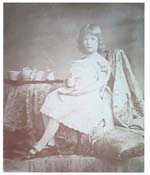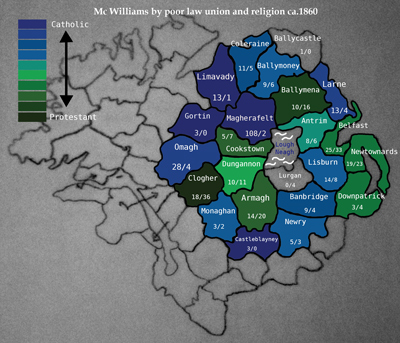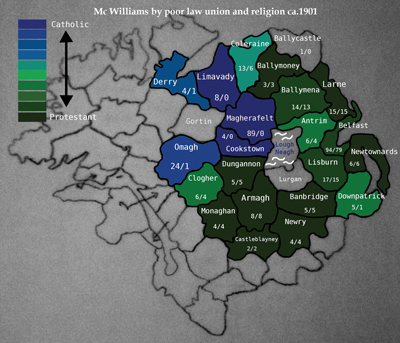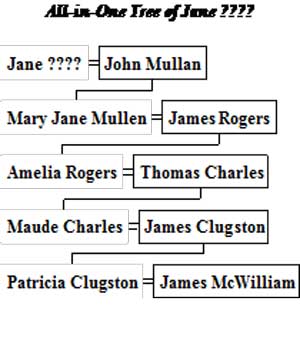This little girl is the only one of my ancestors, back to 1800, not born in south Ulster.
It brings to mind another little girl, her great-grandmother, who was born in India about 1794 and married 11 years later.

DNA
There are three types of DNA test each with its own strengths & weaknesses (Y-DNA, Mitochondrial DNA & Autosomal DNA).
The Y-chromosome is the male determinant and follows the male line. In Patrilineal societies (like Ireland, UK, USA etc) the Y-chromosome will track surnames. It is probably most useful in investigating the deep origins of a family group or surname and so had attracted the interest of academic demographers.
Conversely mitochondria are passed down the direct female line. Because mitochondrial DNA is very small and highly functional, mutations or changes are relatively rare and mitochondria can be passed unchanged for many generations, limiting their use in genealogical studies.
Between 98% & 100% of chromosomal DNA is carried on Autosomal (& X) DNA and this type of analysis promises to be most useful in genealogy. Unlike the other two tests it is not possible to predict directly from which ancestral line a particular block of DNA derives. However matches do serve to identify related individuals. Family trees of matches are then scanned in an attempt to identify a common ancestor. Ideally two or three matches implicating a common ancestor or ancestral group should serve as confirmation.
While more difficult to work with, autosomal DNA tests seem much more promising as an aid or supplement to traditional record based genealogical techniques back to about 1750 which tends to be the time frame of interest to most genealogists. It should be noted however that identification of a common ancestor does require close collaboration and careful matching of genealogical data.
Y-Chromosome DNA analysis
Y-DNA, Mitochondrial DNA & Autosomal DNA
The McWilliams surname is not uncommon in Ulster and two approaches were used to examine the demography of the McWilliams family by religion in Ulster at the middle and end of the nineteenth century.
All McWilliam(s) lessees in Griffith's Property Valuation were recorded by Poor Law Union. In an attempt to estimate the religious breakdown, McWilliam marriages between 1845 and 1863 were also recorded by Poor Law Union (data collected from familysearch.org). Civil registration of non-Catholic marriages began in 1845. It was only in 1864 that registration of all marriages became compulsory. While some Catholic marriages may have been recorded between 1845 & 1863, it is likely that the majority registered were Protestant.
In addition all McWilliam(s) heads of household were recorded by Poor Law Union and religion in the 1901 census.
These results are shown in the two following maps.


Click here for larger versions of the 1860 & 1901 maps.
The numbers shown in Figure 1 are total numbers of householders in each Union in Griffith's Valuation/number of marriages in each Union between 1845 & 1863.
The numbers shown in Figure 2 are numbers of householders in the 1901 census in each Union/number of Protestant householders.
In many cases the numbers are too small to be significant so some differences between the two maps may well be random effects.
Two Y-DNA haplotypes are identified precisely by place in the McWilliams Family Tree Y-haplotype project.
McWilliams Y-DNA (Family Tree)
My DNA, R1a1a (Kit No 278242) is relatively uncommon (2-4%) in Ireland. It is possible to trace my ancestry back to the border of Clogher & Dungannon Unions in the eighteenth or possibly seventeenth centuries. Armagh Union may well be included in this grouping. Most of the McWilliams in this area seem to be Protestant. It should be noted that many of the families in Clogher, Aghaloo & Carnteel parishes seem to have emigrated during the second half of the nineteenth century. It was for this reason that I attempted to extend the analysis back to the 1860s. There are two approximate match shown on the Family Tree McWilliams surname project forming a single group. In total I am aware of 4 approximate matches, all R1a. One of these is from Corick in Clogher parish while another comes from Caledon, Aghaloo parish. These two parishes ajoin Carnteel parish, Co Tyrone where my ancestors can be found in the 18th & possibly even the 17th centuries as described in the link below.
A second haplotype, from Bancran Glebe in Magherafelt Union, is R1b1a2a1a1b4b (Kit No N91328). R1b haplotypes comprise over 80% of Irish haplotypes. In this region the overwhelming number of McWilliams are Catholic. These two haplotypes seem to identify two separate DNA lineages, one presumably native Irish in south Derry and one planter in south Tyrone. The cut off between these two lineages in the hills north of the Clogher valley and between Clogher & Fintona appears to be abrupt.
Origins of the McWilliams R1a haplotype
McWilliams/Williams
Throughout the 18th century in Carnteel parish the name seems to have been written indifferently as McWilliams or Williams, often in the same document. The Church of Ireland vestry minutes for Carnteel parish exist back to the 1740s and the name McWilliams is frequently found. For example William McWilliams/Williams was a vestryman in 1790. In the minutes his name was given as Williams yet he signed as McWilliams.
The deeds below reinforce this impression:
135:424:92081 – Date 18th Oct 1744 Registration 1747
McWilliams, John, Carnteel & Sarah, als Kerr, his wife to Forsyth, John, Aughnacloy
Assignment of 1/6th of the townlands of Tullydraw & Tullybeg
Witness; John Williams, Carenteel
Signed by John and Sarah
337:1:224254 22/3/1780
Wm Moore 1P
John Walker of Drumearn, gent 2P
Wm to John, Drumearn 37a plantation measure
Lives James Willson, eldest son of Chas Willson of Newbliss
Thos Walker, eldest son of Daniel Walker of Tannagh, Tyrone
Oliver McWilliams eldest son of Robert McWilliams, Carnteel, gent now aged one year
Wit: Geo Irvin & Robert Williams of Carenteal
366:39:243593 - Date & Registration 1784
Walker, John, Drumearn to McWilliams Robert Caranteel
Assignment of a farm in Drumnaskallag held by lease from Lord Charlemont in consideration of £50
Witnesses, Richard and Chas Williams of Carnteel, gents
(Richard & Charles McWilliams of Carnteel are mentioned in a number of other deeds)
In the 1766 Religious census there appear to be approximately equal numbers of Williams & McWilliams.
Parliamentary returns as to religion, made by Protestant Rectors, by order of the Irish House of Lords, 15th March, 1766.
Williams, John, Thomas, John, Thomas, John, Christopher, Joseph, James, John & Robert
McWilliams, George, John, Widow, Widow, James, Andrew, George & James
After 1800 the family seem to have settled on McWilliams and there are no references to Williams in the parish of Carnteel.
It seems likely that the original name of this family was Williams and this possibility is reinforced by Y-DNA studies. The south Tyrone McWilliams R1a haplotype is characterised by a specific (Y (388-10)) variant. The Williams page in the Family Tree DNA surnames project has two family groups (#21 & #95) that appear to be R1a also with the Y-388 10 variant. The nearest match in these groups to the south Tyrone McWilliams group is seven mismatches in the Y-37 test. One individual gives an ancestor from Great Yarmouth in the 1500s though in most cases the ancestral origin is not specified.
Family Tree DNA, Williams surname project
In Y-search the nearest match, with 6 mismatches in the Y-37 test, is to a Drake from Devon.
The current data suggests that the south Tyrone McWilliams came to the area from southern England as Williams soon after the Plantation.
This is a very preliminary study and needs additional Y-DNA haplotypes to flesh out these tentative findings. It should be noted that the McWilliams Y-DNA project identifies 4 R1b lineages and a number of individuals who do not fall into discrete groups. It is clear that worldwide the McWilliam name has any number of separate origins. Currently there is not enough data to determine whether the surname in Ulster is subject to similar multiple founding events. It is for example possible, and may in due course be confirmed, that McWilliams on the East coast of Ulster, nearest to Scotland, many of whom are Presbyterian, represent another lineage.
Additional demographic data from the seventeenth & eighteenth centuries can be found in Census records.
Mitochondrial DNA
Y-DNA, Mitochondrial DNA & Autosomal DNA

Mitochondrial DNA is passed exclusively down the maternal line so that, for example, my mitochondria derive from my mother, Patricia, my grandmother, Maud, my great grandmother, Amelia & my 2x great grandmother, Mary Jane. In principle, therefore, it can be used in genealogical studies. Mitochondria are present in every cell where they act to provide energy. They do contain DNA but are highly functional and most mutations or changes in their DNA are lethal. They are thus under intense selective pressure and can remain unchanged for many generations. It follows that many people over many generations will share an identical Mt. DNA sequence, limiting the use of this test in genealogical studies. In practice Mitochondria can be useful in excluding possibilities or in conjunction with other evidence.
My Mitochondrial DNA can be traced back to Killyman Parish, Co Tyrone in the first half of the nineteenth century and details of this analysis are described in the link below.
Maternal or Mitochondrial DNA line
Autosomal DNA
Y-DNA, Mitochondrial DNA & Autosomal DNA
Extending many Irish family trees back beyond the first half of the nineteenth century can often present difficulties. This is partly due to the destruction of civil records in 1922. In addition few church records extend back beyond 1800.
A related issue can be the difficulty of linking families of emigrants back to families in Ireland. The earliest records for many such families may be a census record stating 'born in Ireland' but without a precise location.
DNA studies may well prove to be useful for both of these problems.